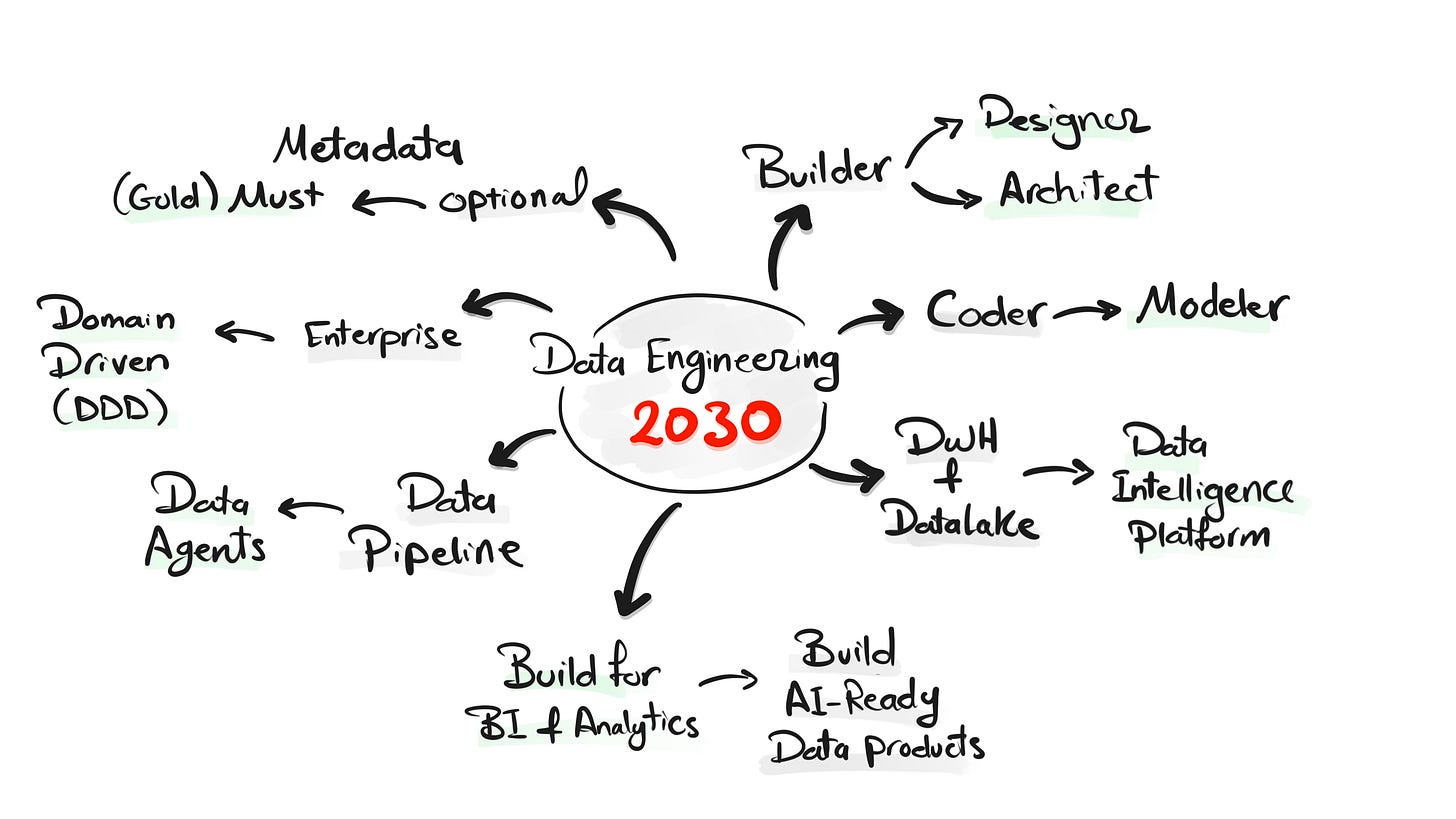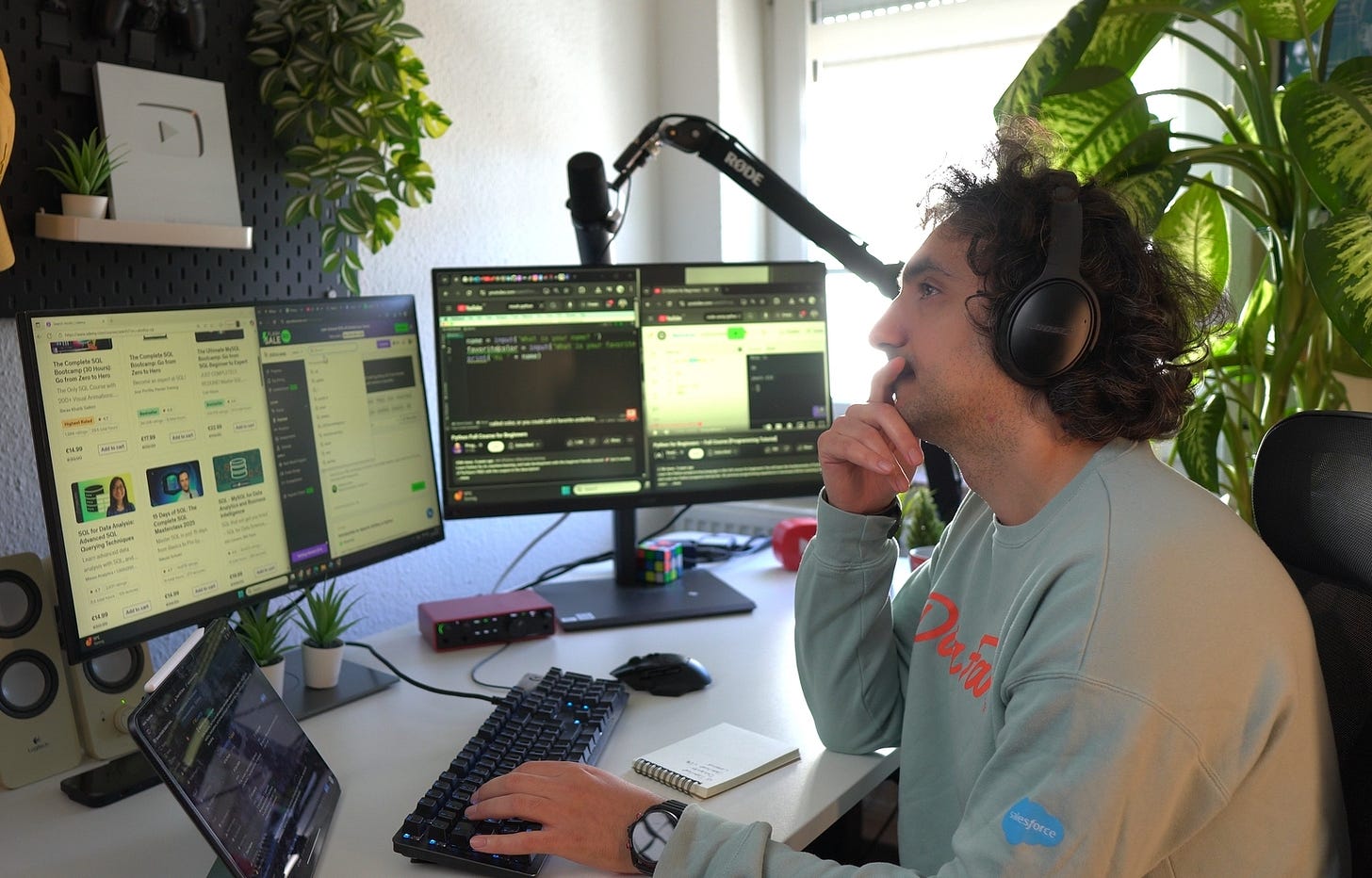The Future of Data Engineering: From Builders to Architects
My honest map of where the field is heading, what skills will matter most, and how to future-proof your career.
Hey friends, Happy Tuesday!
This morning I asked myself a tough question over coffee:
what does data engineering look like by 2030, and how should we prepare now?
I opened the iPad and start brainstorming about to answer it…We are mid-flight, tools are changing fast, and this is where I believe the role is heading.
How Much They’re Betting
Every month Databricks, Snowflake, and Microsoft ship new AI features that automate work we used to hand-code. This is not sci-fi; it is here. Databricks announced a $10B Series J at a $62B valuation to fuel its AI roadmap. Snowflake’s latest research shows that 92% of early adopters are already seeing ROI from AI investments.
When companies pour billions into AI automation, they are not trying to replace engineers overnight. They are betting that the average work will be handled by smarter systems, and that the great engineers will lead the transition.
So your goal is not to fight the tools. Your goal is to outgrow them.
We are mid-flight. It is hard to say exactly how this ends. The best we can do is read the signals: where capital flows, which features keep shipping, and how teams are reorganizing. Tools and strategies are changing fast, and our job description is changing even faster.
How I See the Shift
Here is how I see the shift, and the skills that still matter by 2030.
Here is how I will prepare:
1. From Builder → System Designer & Architect
For years we did it all by hand. We wired sources, wrote ETL, tuned jobs, stood up warehouses and lakes. Ship, ship, ship.
That season is ending. The next season is design.
AI will handle much of the plumbing. Our job shifts to designing the system and orchestrating AI to build it safely. Think of AI as a fast junior team that needs clear intent, constraints, and reviews. We set the blueprint and guardrails; agents do the lifting.
🎯 Start thinking like an architect, not just a coder. Learn to map business needs into system designs, not only pipelines. Move from “How do I build this?” to “Why are we building this?”
2. From Coder → Data Modeler
It was always seen that data engineers are the coders, and modeling was just a nice to have.
This will change.
Our main job will shift toward modeling the data itself.
AI will handle the coding, but it will never understand what the data means.
That part stays human.
We will be the ones defining relationships, naming things correctly, and building models that represent the business.
🎯 Focus on mastering data modeling. Learn how to turn messy business processes into clean, logical data structures that everyone can trust.
3. From Data Warehouses and Lakes → Data Intelligence Platforms
For years we were busy building data warehouses and lakes. The mission was simple: store data, clean it, and make it available.
That era is ending.
The next chapter is about intelligence.
We are moving toward full data intelligence platforms where pipelines, AI models, and business logic live together and learn from each other.
Our job will be to design that intelligence, to build systems that understand context, trace lineage, and feed both people and AI.
🎯 Start learning how data, metadata, and AI connect. Think less about tables and more about ecosystems.
4. From Building Data for BI and Analytics → Building AI-Ready Data Products
For years we built data for BI tools like Power BI and Tableau. We designed star and snowflake models so humans could explore and visualize insights.
That made sense when analytics was the end goal.
Now the goal is different.
We need to build AI-ready data products that can be understood not just by people but by machines.
That means data with full metadata, clear descriptions, and business context built in.
It is not just about shape and structure anymore. It is about meaning and usability for AI models.
🎯 Start thinking beyond dashboards. Learn how to design data that is clean, contextual, and fully documented so both humans and AI can understand and use it confidently.
5. From Data Pipelines → Data Agents
We used to build pipelines. Move data from A to B, schedule the job, and call it a day.
That world is gone.
The future is about data agents smart systems that watch the flow, fix issues, and optimize things on their own.
They will notice when a schema changes, retrain a model, or even alert you when data quality drops.
Our job will be to design how these agents think and act. What to monitor, how to react, and when to ask for human help.
🎯 Get familiar with automation and event-driven design. Learn how AI agents can work inside your data stack and take care of the boring stuff while you focus on the big picture.
6. From Enterprise Data → Domain Data Driven (DDD)
For years, companies tried to manage data as one giant enterprise system. Everything was centralized, slow, and full of bottlenecks.
That approach does not scale anymore.
The future is domain data driven.
Each team owns their data as a product, built around their business domain, with clear contracts and quality standards.
This makes data faster to evolve, easier to trust, and ready to integrate across the company.
It also means data engineers need to understand the business domains they support, not just the tech.
🎯 Get closer to the business. Learn how to design domain-oriented data products that are owned, documented, and connected instead of one big shared mess.
7. From Ignoring Metadata → Treating it Like Treasure
For a long time, metadata was treated like an extra step … nice to have if we had time.
That mindset will not survive the next decade.
In the new data world, metadata is everything.
It tells AI what the data means, helps people trust it, and keeps systems connected and explainable.
Without rich metadata, even the best data pipelines and models lose their value.
🎯 Treat metadata as part of the product, not documentation. Capture meaning, lineage, and ownership directly inside your data systems so both humans and AI know exactly what they are working with.
💭 Final Thought
We are in a mid transition. It is not clear yet where all of this lands.
AI is moving fast, and the tools are rewriting our workflows in real time.
My advice to you: if you are a strong builder and coder, start pushing yourself toward the mindset of an architect and designer.
Learn to think in systems and strategy. Get closer to the business, understand the processes, and learn how to model data that reflects them.
Do this, and I am 100% sure you will be gold.
So stay curious. Keep building. Keep thinking.
Because the future of data engineering is not about tools, it is about the people who know how to connect them.
Thanks for reading ❤️
Baraa
New Video This Week
This week I released a new Python video all about how to Sort & Reverse Lists.
We dive into sort(), sorted(), reverse(), and reversed() — learning how to organize, rank, and flip your data the right way.
These operations are essential in real projects — whether you’re ranking products by price, sorting customer names alphabetically, or cleaning up messy datasets.
Also, here are 3 complete roadmap videos if you’re figuring out where to start:
📌 Data Engineering Roadmap
📌 Data Science Roadmap
📌 Data Analyst Roadmap
Hey friends —
I’m Baraa. I’m an Data Engineer professional and YouTuber.
My mission is to share the knowledge I’ve gained over the years and to make working with data easier, fun, and accessible to everyone through courses that are free, simple, and easy!





For the next year, if data architecture and design are the future, then you are the one for us who aspire to be in this career. Every post you share and every video you make is so helpful for us nowadays.
Collaborating with AI will push coders a step ahead, and for data enthusiasts, it has to be following data with Baraa that’s how it has to be.
Excellent Article Baraa, I was thinking about this and trying to know where my job is heading. Please keep posting about this topic if any updates happened. Thanks again 😄